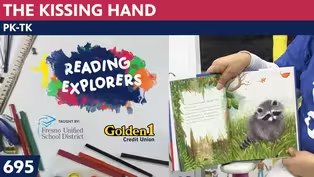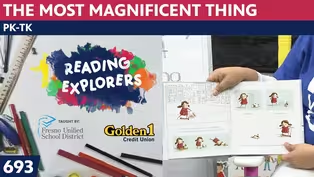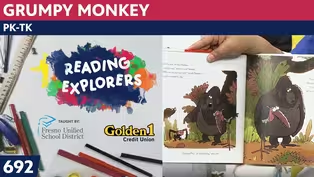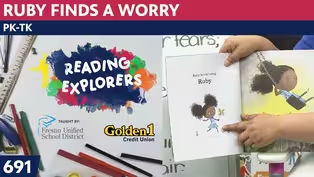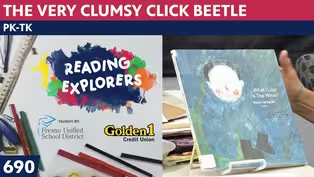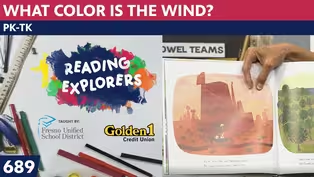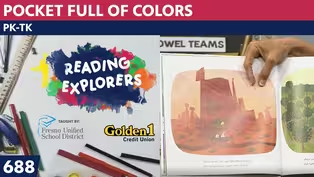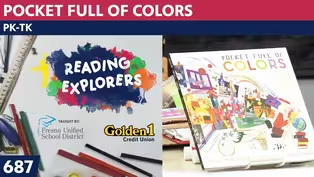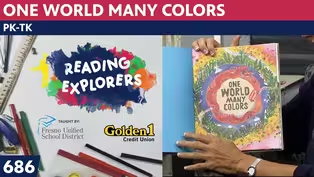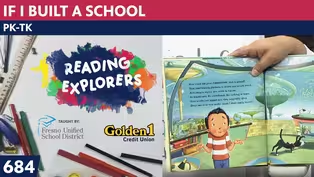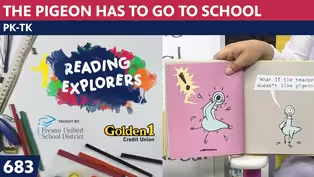
TK-361: Paul Cézanne's Mont Sainte Victoire
Season 3 Episode 337 | 14m 14sVideo has Closed Captions
Join Mrs. Readwright at Camp Discovery!
Join me today as we begin an Earth Day celebration week. Each day we will introduce masterpieces that illustrate a part of our beautiful planet Earth. Four days this week, we will work on one project...adding another part of the earth. We will create the land, water, air and outer space. Today we have Cezanne's Mont Sainte Victoire. If you would like to make artwork that shows mountains like Pau
Problems playing video? | Closed Captioning Feedback
Problems playing video? | Closed Captioning Feedback
Reading Explorers is a local public television program presented by Valley PBS

TK-361: Paul Cézanne's Mont Sainte Victoire
Season 3 Episode 337 | 14m 14sVideo has Closed Captions
Join me today as we begin an Earth Day celebration week. Each day we will introduce masterpieces that illustrate a part of our beautiful planet Earth. Four days this week, we will work on one project...adding another part of the earth. We will create the land, water, air and outer space. Today we have Cezanne's Mont Sainte Victoire. If you would like to make artwork that shows mountains like Pau
Problems playing video? | Closed Captioning Feedback
How to Watch Reading Explorers
Reading Explorers is available to stream on pbs.org and the free PBS App, available on iPhone, Apple TV, Android TV, Android smartphones, Amazon Fire TV, Amazon Fire Tablet, Roku, Samsung Smart TV, and Vizio.
Providing Support for PBS.org
Learn Moreabout PBS online sponsorshipMore from This Collection
Valley PBS and Fresno Unified School District have partnered with Golden 1 Credit Union to create Reading Explorers Lessons for grades Pre-Kindergarten through Third grade. The daily lessons will be taught by Fresno Unified School District teachers and are created to help students practice their reading skills and reinforce lessons during distance learning.
Video has Closed Captions
Valley PBS presents Reading Explorers Lessons for Pre-Kindergarten and TK. (26m 27s)
PK-TK-693-The Most Magnificent Thing
Video has Closed Captions
Valley PBS presents Reading Explorers Lessons for Pre-Kindergarten and TK. (26m 26s)
Video has Closed Captions
Valley PBS presents Reading Explorers Lessons for Pre-Kindergarten and TK. (26m 28s)
Video has Closed Captions
Valley PBS presents Reading Explorers Lessons for Pre-Kindergarten and TK. (26m 28s)
PK-TK-690: The Very Clumsy Click Beetle
Video has Closed Captions
Valley PBS presents Reading Explorers Lessons for Pre-Kindergarten and TK. (26m 22s)
PK-TK-689: What Color is the Wind?
Video has Closed Captions
Valley PBS presents Reading Explorers Lessons for Pre-Kindergarten and TK. (26m 21s)
PK-TK-688: Pocket Full of Colors
Video has Closed Captions
Valley PBS presents Reading Explorers Lessons for Pre-Kindergarten and TK. (25m 58s)
PK-TK-687: Dancing Through Fields of Colors
Video has Closed Captions
Valley PBS presents Reading Explorers Lessons for Pre-Kindergarten and TK. (26m 20s)
PK-TK-686: One World Many Colors
Video has Closed Captions
Valley PBS presents Reading Explorers Lessons for Pre-Kindergarten and TK. (27m 13s)
PK-TK-685: School is Wherever I am
Video has Closed Captions
Valley PBS presents Reading Explorers Lessons for Pre-Kindergarten and TK. (26m 32s)
PK-TK-684: If I Built a School
Video has Closed Captions
Valley PBS presents Reading Explorers Lessons for Pre-Kindergarten and TK. (26m 21s)
PK-TK-683: The Pigeon Has to Go to School
Video has Closed Captions
Valley PBS presents Reading Explorers Lessons for Pre-Kindergarten and TK. (26m 22s)
Providing Support for PBS.org
Learn Moreabout PBS online sponsorship♪ Good morning to a brand new day ♪ ♪ Time to learn and games to play ♪ ♪ Learning things is so much fun ♪ ♪ Learning is good for everyone.
♪ (bright upbeat music) - Hello, early learners.
Welcome back to the art room.
It's me, Mrs. Readwright.
I am getting ready to unpack my suitcase.
I'd covered it up with all of my belongings cause I thought I'd start somewhere else but it is Mystery Monday.
So before I tell you what we're doing, let's take a look and see if you can figure it out.
All right, suitcase, come on up here.
I have three items in here and they all go together.
And I wonder if you will be able to figure out why I brought these three items.
Open the suitcase and let's see what's in here.
I have this first jar.
There's something in there, but you can't see it.
Here's my second jar.
(liquid swirling) What could that be?
And my third jar.
I'm going to tell you the three items.
There is soil or dirt, there is air, and there is water.
These three things are around us every day.
They are all part of our planet, Earth.
Is that what you were thinking?
We have the air, we breathe, the water that we drink and use for all kinds of activities and for recreation and the soil we walk on because even beneath your floor in your house, there is soil beneath there.
So these three things are things we need to help take care of.
So it will always be fresh and clean for the people who live here.
So Earth Day was established in 1970.
People were realizing that our earth was being trashed and people weren't taking as good care of it as they should.
People would throw things out of their cars and think, somebody will pick that up.
Or they poured oil down the drain, which goes out to where the fish live, or they just put burning smoking things in their backyards and burn up things and the smoke goes into the air.
All of these things are things that damage our planet.
So we can do things to help our planet stay clean.
And our planet is Earth and you can help.
You can recycle things.
You can make sure that you don't put things down the drain that don't belong there.
We'll talk about a lot of things that we can do to help the earth.
I also have inside the suitcase, a book that I think many of you have had in your classroom.
And if you haven't, we have hundreds of copies of this book in our libraries at Fresno Unified.
And I'm sure those of you who go to other schools like in Clovis and Sanger and Selma and Kingsburg, you can find this book at your county library or at your school library.
And it kinda goes along with the song that Greg and Steve sing about, ♪ Oh, we all live together ♪ ♪ Yes, we all live together.
♪ And they start out with a girl who's on the map.
And it goes from her to her bedroom.
So it just says, ♪ I live in a house in a neighborhood ♪ ♪ The neighborhood is a part of a city ♪ And it goes on and on until she finally gets to outer space.
Well, I thought, what would be a really fun art project that's going to last all week long that we could do together that shows the planet Earth?
I'm going to use a gigantic piece of white paper and draw a big circle in it.
And we'll start out with the circle and put in all the parts we just talked about.
About the land, the water and the air and outer space.
I think you're gonna have fun making it but I want you to know, that when you work on your project you have to put it somewhere safe at night so that other people don't accidentally spill something on it or they think it's just a scrap piece of paper when it's really your precious artwork.
So every night I'm going to hang mine up.
And I might even hang it in my closet with a clothes pin so nobody thinks it's something they can use.
But we're going to get started.
Let's start with a new hello song.
And the new hello song goes like this; ♪ It's the more we get together ♪ ♪ Together.
♪ So I'm gonna do, (hums) It's to a waltz beat.
And a waltz beat is, one, two, three, one, two, three.
♪ The more we get together ♪ ♪ Together, together, together ♪ ♪ The more we get together ♪ ♪ The happier we'll be ♪ ♪ Cause your friends are my friends ♪ ♪ And my friends are your friends ♪ ♪ The more we get together, ♪ ♪ The happier we'll be.
♪ And that is our song and I even put the cords on it because one day this week, I might play my instrument and play this song.
Let me set this down and let's talk about the art that we're going to look at today.
On this chart, is the art a child made.
And this is the one we're going to make.
I'm going to start out with a piece of white paper draw the circle, make the mountains first then make the hills and valleys then put the forest, then add the river, then add the ocean then add the outer space.
Those are the steps.
And we're gonna try and see how much we get finished because each time we do art in our studio I bring back the extra art that I finished at home so you can see.
And behind me is all the art from last week.
And I wanted to tell you about it because this one where we did a collage with torn colored paper from the magazine I collected all lights and greens and dark greens to make this pair.
And then I did the words in the background.
On Wednesday which is Earth Day, the anniversary of the Earth Day.
The first one I told you was 1970.
And then they didn't do it again until 1980.
And then they didn't do it again until 1990.
But since 1990, there was a Congressman who said, "I wanna do Earth Day every day.
Let's move it to April 22nd so that all the children in school will do something with their teacher."
So ask your teacher what she has or he has planned for you for Wednesday, for Earth day.
Maybe they'll do this project with you or maybe you'll do it beforehand.
But what I wanted to tell you was make sure you collect green paper from a magazine, blue paper from a magazine and black for outer space.
That will be for Wednesday but I wanted to remind you today to collect those things.
Let's take a look right now at Cezanne's Mount St. Victoria.
Now this mountain, Cezanne painted, I think I read over 200 times.
He loved this mountain and interesting about this print itself, it's really cut into three parts.
Here's the horizon line where the mountain is painted then about right here is where all of the trees are then from here down in the foreground you can see there are small buildings in the picture.
And all of his work was being painted this way and that way, his brush strokes impressionistic.
Remember we talked about that?
It was what he saw and painted.
Now, the thing about Cezanne, do you remember?
He never signed his work.
He never thought it was finished.
Why sign a piece that's not finished?
So he never signed his work.
And this one, as a matter of fact, you can pieces of the canvas behind coming through because he didn't paint on every piece of the paper.
So he was painting all of this and not finishing it.
Oh, there's a little piece there that he didn't paint.
But what we're going to do is just look at the mountain and how he put different shades of grays and lavenders up here because when we go to do ours you can see the person who did this artwork did it in a stylized fashion.
Stylized means kind of cartoonish.
It doesn't really look like a real one where this one from Cezanne looks like a real mountain.
So let's get started.
You may want to get your piece of white paper and use a dinner plate to do your circle.
I am using a tool called a compass.
Goes on here and that's gonna go make a circle on my paper.
And I have the tiny one I have here to put up here to show you as we go on.
So let me set down my pointer stick.
I'm not worried about having to stop in the middle of the lesson this time because we're going to do this all week long so we don't need to worry.
This way I can turn my table down a little bit.
I tried to put a little dot in the middle of my paper because when you use this you keep this on there and you move the pencil that's attached to the other end around in a circle.
Let's see if I can do it without making a mistake by moving my little thing off of the, it's kinda hard cause this is the biggest compass I've ever used.
Press a little bit Mrs. Readwright.
I'm gonna move my paper a little bit this way, put it back on here.
It's gonna make a pretty good circle, boys and girls.
I think it will make it way around and meet up cause a circle is a curve that never ends.
Yeah, that's pretty good, it doesn't have to be perfect.
Closing it up, setting it aside.
I'm going to be using permanent pens all week long too.
So if you have one, good for you.
If you don't, you'll use a black crayon or you'll use a black pastel.
But what I'm going to do is now trace this line, I'll bring this up so that we can keep looking and you can see what we're doing.
I'm going to have to use just my hand to kinda stay steady.
So it might bump down cause it runs into the edge of my little table.
But I'm going around and I'm making my circle as great and straight as I can.
I'm not worried though, if it's a little wiggly cause I think what the Earth out in space it's not a perfect, perfect sphere.
Here we go.
Now I've got that part done.
I'm going to do my mountains.
Now I have to know I'm gonna do the mountains, the hillsides and the water.
So I'm going to do this hillside and another hillside so that I can start my mountains.
I'm going to put one mountain up and touch the hillside another mountain, a different size and touch the hill.
And another one.
You can put as many mountains as you'd like.
And what I want to do, is add the snow to it.
So I'm going to turn this so you can see it.
I will draw the place where the snow is kind of on the top of the mountain.
And I'm going to use my white pastels because tomorrow when I paint this, I want the white snow to stay there.
So let me grab my white pastels and just color in that part.
Now tomorrow we're going to do a forest landscape.
And so you'll bring this project back, your oil pastels, if you have them, or if you're bringing crayons, bring your crayons because we're just gonna draw forest in this part.
All right?
So make sure that if you want to do this project with me bring this project back and we'll have a great time with it.
Boys and girls, it's almost time to say goodbye.
So I'm gonna do a little, Oh, it's time to say goodbye to all my friends.
♪ Oh, it's time to say goodbye to all my friends ♪ ♪ Oh, it's time to say goodbye to all my friends ♪ Boys and girls, I'll see you tomorrow to meet Emily Carr and her forest landscape.
Bye-bye.
(bright upbeat music) ♪ Good morning to a brand new day ♪ ♪ Time to learn and games to play ♪ ♪ Learning things is so much fun ♪ ♪ Learning is good for everyone ♪ (bright upbeat music)
Support for PBS provided by:
Reading Explorers is a local public television program presented by Valley PBS
